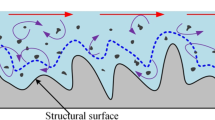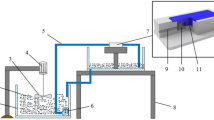Abstract
The spatial structure of the constrained space determines the polishing efficiency and polishing quality of the soft abrasive flow (SAF) polishing method. A basic SAF polishing mode with universal guiding significance was built in this paper, and the effect of the spatial structure of constrained space on SAF polishing was studied. Based on the coupling of the Euler’s multiphase flow model and the standard turbulence model, a SAF hydrodynamic model was constructed to obtain the dynamic characteristics of the abrasive flow in the constrained flow passage and to reveal how the key parameters determining the spatial structure of constrained space affect the SAF polishing. The results showed that the inlet angle of the constrained space determines the injection posture of the abrasive flow. When the inlet angle reduces, the impact between the abrasive flow and the constrained wall is weakened, and the distributions of fluid turbulent kinetic energy, dynamic pressure, and granular pressure tend to be uniform. The height of the constrained space is a key factor affecting the polishing efficiency of the SAF. As the height of the space decreases, the material removal rate is enhanced significantly, but the turbulent impact ability of the abrasive particles is weakened. The height of the constrained space should be set to near the critical value of turbulent flow variation. Based upon the simulation, an experimental platform for SAF polishing was built, and the accuracy of the simulation results and the effectiveness of the polishing method were verified by the comparative polishing experiments.












Similar content being viewed by others
Data Availability
All data generated or analyzed during this study are included in this published article.
References
Beaucamp A, Namba Y (2013) Super-smooth finishing of diamond turned hard X-ray molding dies by combined fluid jet and bonnet polishing. Crip Ann-Manuf Technol 62(1):315–318
Xu H, Wen DH, Ou CJ (2014) Preparation of ultra-smooth and free-defect copper substrate for amorphous alloy films. J Mech Eng 50(1):162–168
Guo DM, Liu JY, Kang RK, Jin ZJ (2007) A pad roughness model for the analysis of lubrication in the chemical mechanical polishing of a silicon wafer. Semicond Sci Tech 22:793–797
Qi H, Qin SK, Cheng ZC, Teng Q, Hong T, Xie Y (2021) Towards understanding performance enhancing mechanism of micro-holes on K9 glasses using ultrasonic vibration-assisted abrasive slurry jet. J Manuf Process 64:585–593
Qin CJ, Hu ZH, Tang AM, Yang ZP, Luo S (2020) An efficient material removal rate prediction model for cemented carbide inserts chemical mechanical polishing. Wear 452:203–293
Chen ZZ, Qi H, Zhao B, Zhou Y, Shi LW, Li HN, Ding WF (2021) On the tribology and grinding performance of graphene-modified porous composite-bonded CBN wheel. Ceram Int 47(3):3259–3266
Li HN, Zhao YJ, Cao SY, Chen H, Wu CQ, Qi H, Sun X, Wang HX, Li CH, Liu GY (2021) Controllable generation of 3D textured abrasive tools via multiple-pass laser ablation. J Mater Process Technol 295:117149
Ge JQ, Li C, Gao ZY, Ren YL, Xu XS, Li C, Xie Y (2021) Softness abrasive flow polishing method using constrained boundary vibration. Powder Technol 382:173–178
Zhao TC, Deng QF, Zhang C, Feng KP, Zhou ZZ, Yuan JL (2020) Orthogonal Experimental Research on Dielectrophoresis Polishing (DEPP) of silicon wafer. Micromachines 11(6):544–557
Han YJ, Duan F, Zhu WL, Zhang L, Beaucamp A (2020) Analytical and stochastic modeling of surface topography in time-dependent sub-aperture processing. Int J Mech Sci 175:105575
Guo ZF, Jin T, Xie GZ, Lu AG, Qu MN (2019) Approaches enhancing the process accuracy of fluid jet polishing for making ultra-precision optical components. Precis Eng 56:20–37
Das M, Jain VK, Ghoshdastidr PS (2008) Fluid flow analysis of magnetorheological abrasive flow finishing (MRAFF) process. Int J Mach Tool Manu 48(3–4):415–426
Kim JD (2002) Motion analysis of powder particles in EEM using cylindrical polyurethane wheel. Int J Mach Tools Manuf 42:21–28
Lin B, Jiang XM, Cao ZC, Li Y (2018) Novel disc hydrodynamic polishing process and tool for high-efficiency polishing of ultra-smooth surfaces. Micromachines 9(7):333–344
Ji SM, Li J, Tan DP (2016) Numerical and experimental study on softness abrasive flow finishing based on turbulence enhancement by ultrasonic vibration. J Mech Eng 52(21):182–189
Li J, Ji SM, Tan DP (2017) Improved soft abrasive flow finishing method based on turbulent kinetic energy enhancing. China J Mech Eng 30(2):301–309
Ji SM, Cao HQ, Zhao J, Pan Y, Jiang EY (2019) Soft abrasive flow polishing based on the cavitation effect. Int J Adv Manuf Technol 101(5–8):1865–1878
Li C, Xu QD, Ge JQ, Li ZA, Guo LM (2020) Study of soft abrasive flow field measurement based on particle image velocimetry. Int J Adv Manuf Technol 109(7–8):2039–2047
Ge JQ, Hu WP, Xi YX, Ren YL, Xu XS, Zhang C (2021) Gas-liquid-solid swirling flow polishing and bubble collapse impact characteristics. Powder Technol 390:315–329
Zhang L, Yuan ZM, Qi ZJ, Cai DH, Cheng ZC, Qi H (2018) CFD-based study of the abrasive flow characteristics within constrained flow passage in polishing of complex titanium alloy surfaces. Powder Technol 333:209–218
Tan DP, Ji SM, Fu YZ (2016) An improved soft abrasive flow finishing method based on fluid collision theory. Int J Adv Manuf Technol 85(5–8):1261–1274
Qi H, Qin SK, Cheng ZC, Zou YL, Cai DH, Wen DH (2021) DEM and experimental study on the ultrasonic vibration-assisted abrasive finishing of WC-8Co cemented carbide cutting edge. Powder Technol 378:716–723
Tan DP, Li L, Yin ZC, Li DF, Zhu YL, Zheng S (2020) Ekman boundary layer mass transfer mechanism of free sink vortex. Int J Heat Mass Tran 150:119250
Zhang L, Wang JS, Tan DP, Yuan ZM (2017) Gas compensation-based abrasive flow processing method for complex titanium alloy surfaces. Int J Adv Manuf Technol 92(9–12):3385–3397
Geng F, Teng HX, Gui CG, Wang YC, Yuan LJ, Yang YY, Xu DY (2020) Investigation on distribution characteristics of flexible biomass particles in a fluidized bed riser. Fuel 271:117528
Zhang L, Ji RQ, Fu YF, Qi H, Kong FZ, Li HN, Tangwarodomnukun V (2020) Investigation on particle motions and resultant impact erosion on quartz crystals by the micro-particle laden waterjet and airjet. Powder Technol 360:452–461
Funding
This research was funded by the National Natural Science Foundation of China (No. 51905515), the China Postdoctoral Science Foundation (No. 2020M671709), the Fundamental Research Funds for the Provincial Universities of Zhejiang (No. 2021YW05), and the scientific research and innovation activity plan of university students in Zhejiang Province (No. 2021R409017).
Author information
Authors and Affiliations
Corresponding author
Ethics declarations
Ethics approval
Not applicable.
Consent to participate
Not applicable.
Consent for publication
Not applicable.
Conflict of interest
The authors declare no competing interests.
Additional information
Publisher's Note
Springer Nature remains neutral with regard to jurisdictional claims in published maps and institutional affiliations.
Rights and permissions
About this article
Cite this article
Ge, Jq., Zhou, Ht., Li, C. et al. Soft abrasive flow polishing method and optimization research on the constrained space. Int J Adv Manuf Technol 118, 1673–1688 (2022). https://doi.org/10.1007/s00170-021-08043-w
Received:
Accepted:
Published:
Issue Date:
DOI: https://doi.org/10.1007/s00170-021-08043-w




